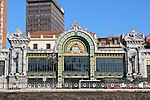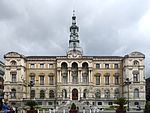Bilbao-Abando railway station

The Abando Indalecio Prieto railway station (Basque: Abandoko Indalecio Prieto geltokia, Spanish: Estación de Abando Indalecio Prieto), usually known simply as Bilbao-Abando and previously known as Estación del Norte (North Station) is a terminal railway station in Bilbao, Basque Country (Spain). The name comes from Abando, the district in which the station is located, and Indalecio Prieto, who was Minister of Public Works during the Second Spanish Republic. The station serves as the terminus station for several long and medium distance services operated by Renfe as well as commuter rail services within the Bilbao metropolitan area operated by Cercanías. The station has direct access to Metro Bilbao and to the tram, as well as many local and regional bus lines. The railway station Bilbao-Concordia, operated by Renfe Feve is located in close proximity. After the construction of the high-speed line Basque Y is finished, Bilbao-Abando will serve as the western terminus, which will involve the creation of a completely new station replacing the current one.
Excerpt from the Wikipedia article Bilbao-Abando railway station (License: CC BY-SA 3.0, Authors, Images).Bilbao-Abando railway station
Gran Vía Don Diego López de Haro / On Diego Lopez Haroko kale nagusia, Bilbao Abando
Geographical coordinates (GPS) Address Nearby Places Show on map
Geographical coordinates (GPS)
| Latitude | Longitude |
|---|---|
| N 43.261388888889 ° | E -2.9277777777778 ° |
Address
Gran Vía
Gran Vía Don Diego López de Haro / On Diego Lopez Haroko kale nagusia
48001 Bilbao, Abando
Autonomous Community of the Basque Country, Spain
Open on Google Maps










